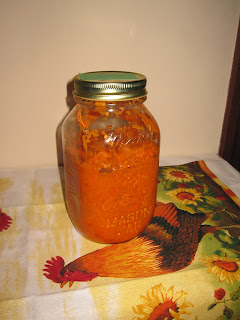 |
| Ginger Carrots lacto-fermenting quietly in a mason jar. |
Did you ever wonder how people managed before the advent of refrigeration? Root cellars, cured and smoked meats, and lacto-fermented vegetables all played important roles. I suppose that lacto-fermentation could be considered a form of canning; after all, we store the products in canning jars. Using the whey separated from raw milk to provide lactic acid, traditional cultures preserved vegetables to last until the the next harvest season. Thus, summer and fall vegetables could be available in the dead of winter.
Ginger Carrots is a dish that goes well with spicy meats and provides a gentle introduction to lacto-fermented foods for the sensitive palate. The recipe we use is from page 95 of Sally Fallon's Nourishing Traditions cookbook. If you want to live well and are interested in how traditional cultures managed to live in supremely good health before "civilization" descended with our processed foods and the like, then you need to discover the Weston A. Price Foundation and Nourishing Traditions.
My friend Tanya valiantly grated about 6 cups of carrots (the recipe calls for four but we were aiming to fill two mason jars--until we ran out of carrots) and a well-rounded tablespoon of ginger (nearly two tablespoons). I ground a tablespoon of sea salt. (The recipe calls for one tablespoon, but again I thought we would be getting a double recipe; I generally cut salt in half in recipes--when I use it at all.) Finally, the recipe called for 4 tablespoons of whey; we probably used six.
Next, Tanya got to pound the combined ingredients until the vegetable juices blended with the whey enough to cover the vegetables in the jar. Since the wooden tool we have to use is small, the task was difficult. I keep meaning to fashion a better tool since we have abundant stores of wood here, but have yet to get to that particular project.
After much labor--indeed, Tanya worked the entire time I was cooking up a batch of fresh ricotta using 1-1/2 gallons of raw goat milk--Tanya announced that the finished vegetables would fit in one jar. Although it seemed like a supreme amount of effort for the amount of product, I know that the flavor will be so delightful as to make the trouble well warranted.
When eating lacto-fermented vegetables, such as homemade sauerkraut, a healthy tablespoon size serving each day will provide the enzymes necessary for a balanced and healthy intestinal tract--deliciously!
Thank you, dear Tanya, for your efforts. We will think of you fondly as we enjoy the fruits of your labor in the coming months.
No comments:
Post a Comment